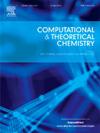过渡金属修饰磷烯纳米片作为二氧化碳还原催化剂的可行性:理论研究
IF 3
3区 化学
Q3 CHEMISTRY, PHYSICAL
引用次数: 0
摘要
用计算方法研究了过渡金属修饰的磷烯催化剂对CO2的还原作用。计算表明,金属-磷烯相互作用调节催化活性。金属修饰的磷烯纳米片的吉布斯自由结合能在- 73.3 ~ - 83.2 kcal/mol之间,其中Mn的结合能最高。反应途径研究表明,CO2与H2的还原比CO更有利于HCOOH的生成。随后HCOOH还原为CH2O和CH3OH对Mn和Fe的能垒较低,而Ni的能垒较差。由MeOH生成CH4需要很高的活化能,只有在中等加热(400 K)下才可行。结果强调了对HCOOH和CH3OH的选择性,避免了CH2O直接生成CH4。Mn和fe修饰的磷烯体系在环境或中等加热条件下具有高活性和选择性,是很有前途的CO2还原催化剂,而Ni则表现出局限性。本文章由计算机程序翻译,如有差异,请以英文原文为准。

Viability of transition metal decorated phosphorene nanoflakes as catalysts for carbon dioxide reduction: A theoretical study
The reduction of CO2 using transition metal-decorated phosphorene catalysts was investigated via computational methods. Calculations revealed that metal-phosphorene interactions modulate catalytic activity. Phosphorene nanoflakes decorated with metals exhibited Gibbs free binding energies between −73.3 and − 83.2 kcal/mol, with Mn showing the highest binding energy. Reaction pathway studies indicated that CO2 reduction with H2 favors HCOOH formation over CO. Subsequent reduction of HCOOH to CH2O and CH3OH displayed lower energy barriers for Mn and Fe, while Ni showed inferior efficacy. CH4 formation from MeOH required high activation energies, becoming viable only under moderate heating (400 K). Results highlighted selectivity toward HCOOH and CH3OH, avoiding direct CH4 formation from CH2O due to prohibitive kinetic barriers. Mn- and Fe-decorated phosphorene systems emerged as promising catalysts for CO2 reduction, offering high activity and selectivity at ambient or moderately heated conditions, whereas Ni exhibited limitations.
求助全文
通过发布文献求助,成功后即可免费获取论文全文。
去求助
来源期刊

Computational and Theoretical Chemistry
CHEMISTRY, PHYSICAL-
CiteScore
4.20
自引率
10.70%
发文量
331
审稿时长
31 days
期刊介绍:
Computational and Theoretical Chemistry publishes high quality, original reports of significance in computational and theoretical chemistry including those that deal with problems of structure, properties, energetics, weak interactions, reaction mechanisms, catalysis, and reaction rates involving atoms, molecules, clusters, surfaces, and bulk matter.
 求助内容:
求助内容: 应助结果提醒方式:
应助结果提醒方式:


